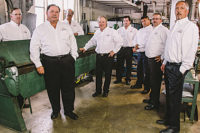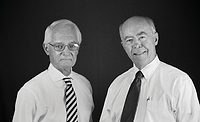Click here to check out the video interview!
In the early 1990s, Guy Akasaki was working as president and project manager for one of the largest roofing companies in Hawaii when the economy took a turn for the worst. After much debating over whether or not to sell the company, the owner decided to hold on to the business but needed singularity of ownership, so Akasaki resigned after 14 years with the promise that he would not compete for one year. He then considered many new business ventures, including opening a Subway franchise, but ultimately chose to stay true to his roots in architecture and contracting.
“In March of 1993, I started a roofing company — undercapitalized, underfunded, undermanned, and with no bonding and no line of credit. I had a banker telling me I shouldn’t get into contracting, but I told him I was going to make it,” Akasaki said. “The next seven months were pure stress, as the only people I could approach were new contacts who did not have a high regard for new roofing contractors. I had to start knocking on doors and talking to people I didn’t know, but people who threw proposals in my face are now some of my biggest customers and friends.”
While it was difficult not to compete in the beginning, Akasaki kept his word. “Because I had been in the industry for so long, it was hard not to pick the low-hanging fruit,” he said. “People started to come to me and offer me jobs that I had to turn down, but it felt good to do the right thing.”
Despite Akasaki’s unique situation and the tough economic conditions of the time, the company experienced significant growth early on and has continued to thrive. More than 20 years later, Akasaki still owns the company with his wife, Lanette Akasaki, who was his girlfriend when they first went into business.
“My wife and I started the company,” he explained. “The first year laid the groundwork for who we are today. It taught us a lot about value, commitment and integrity. It was a lesson in life that no university could teach me — the power of commitment, honesty, integrity and honor. I look at it with a lot of reflection, because those are my roots, but it’s an education you definitely don’t want to go through twice. That was the year I actually grew up.”
Located in Honolulu, Hawaii, Commercial Roofing & Waterproofing Inc. now focuses primarily on commercial and industrial roofing, and above- and below-grade waterproofing. The company currently serves all Hawaiian Islands, has offices in the Philippines and Guam, and does special projects in Hong Kong. CRW has also established several strategic partnerships to expand its capabilities, including Honolulu Roofing, the company’s union shop; Allied Pacific Builders, a general construction firm that specializes in building renovations; SFSI, a project development and finance company; EnRG Solutions International, a patent and IP holding company; and GreenPath Technologies, a solar contractor that specializes in solar power integration and renewable energy.
When asked which entity has been the most successful, Akasaki said, “I would say CRW, as it was the birthing mother that allowed this collaboration of strategic companies to flourish and continues to establish a strong and progressive footprint in our state. Our growth strategy isn’t just about getting bigger, it’s about creating profit centers. The roofing surface is part of the building envelope. The roof once generated no revenue for the owner, but today it becomes an income-producing asset.”
Greening the Islands
CRW prides itself on being an industry leader in cutting-edge construction technology, solar solutions and green initiatives. The company always considered energy efficiency a top priority, so when the industry began moving toward more sustainable practices, CRW was quick to adapt and excel.
“The reason we have a lot of things separated is because when solar started, we already knew the mindset of roofing contractors, so we started a company that was very unique to the industry — and had a close affiliation with solar,” Akasaki explained. “Our values in roofing were in energy savings and sustainability, and we were already in the commercial real estate brokerage arena. As a result, we easily saw the connection. Not only did we do contracting, but we understood that there was a convergence of disciplines — nanotechnology, turnkey interfaces within the realm of finances, taxes credits, subsidies, current accounting protocols and asset valuation impacts — and have been able to capitalize on this.”
The company has expertise in building integrated photovoltaic systems, which can provide energy savings for owners, taking their roofs from liabilities and converting them into assets. Photovoltaic systems can add visual appeal to buildings as well. Recent notable projects include Unicold, the largest cold-storage facility in Hawaii, where CRW re-roofed the facility with a 60-mil Sarnafil cool roof system and a photovoltaic system that allowed for tax credits; and Honolulu’s Hawaii National Bank, which was a turnkey roofing and photovoltaic installation — Hawaii’s tallest to date when installed — to meet the building’s renewable energy needs.
The company is committed to installing sustainable systems that minimize pollution and harm to the islands’ surrounding ecosystems, including a variety of solar, cool and green roof applications.
“Hawaii is a very small place, and roofing can be a very messy project resulting in a negative impact to our environment,” Akasaki said. “Early on, we installed systems that were high on performance and sustainable in life, minimizing the demolition to an existing assembly, and coating systems using nanotechnology to increase solar reflectivity and low emissivity. For this area to be a successful one for us, which it has, we research the makeup of a product to better understand it beyond the marketing materials.”
Having profound knowledge of the products and systems its using allows CRW to suggest the best possible solution for each project. “We give really insightful recommendations,” Akasaki said. “At the end of the day, it’s not for us — it’s for the customers.”
When it comes to ongoing education — whether it be about products, safety or any other aspect of the job — Akasaki encourages his employees to learn from each other. “Every Monday morning we have all employees at safety meetings, and the workers hold the meetings,” he said. “We actually involve our key guys. They stand up in front of the men and articulate. In many instances, it’s very difficult. We have them stand in front of people to become involved and communicate. We’ve been doing it for many years, and it’s done a lot for their personal development. Retention is very powerful. Put them in positions where their peers see them, and there’s a sense a pride. Let them be a part of the process and man, it’s powerful.”
Pursuing a Passion
According to Akasaki, CRW and its affiliates have continued to succeed because he and his team are passionate about the business. “When I was considering Subway, I was doing it out of duty rather than passion — my background is in architecture,” he explained. “If you have a passion and desire to do what you do best, then you can supply a service to your customers. At the end of the day, it really is about relationships. It’s not about making money off your customers, it’s about meeting their needs — and when that happens, the money will come.”
In the company’s unique market, building these customer relationships is crucial. “We try to really understand our customers by getting involved in their industries to see the roadblocks they face and how we as professionals can service their needs,” Akasaki said. “It’s really about exceeding expectations, and to do that we have to understand.”
CRW strives to operate by its mission statement, which is to be a unified team of professionals that uses its knowledge and experience to be on the forefront of cutting-edge construction technology and ultimately exceed its clients’ expectations.
Akasaki believes that success is more of a process than a destination, and he and his company are constantly preparing for what the future may hold. “We live by the understanding that in times of feast, when economic times are great, to plan for the times of famine, and in times of famine, plan for the times of feast.”











Report Abusive Comment